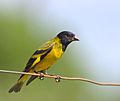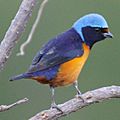Finch facts for kids
Quick facts for kids True finch |
|
|---|---|
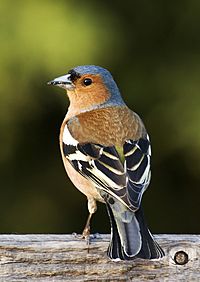 |
|
| Adult male Chaffinch (Fringilla coelebs) of the Fringillinae |
|
| Scientific classification | |
| Kingdom: | |
| Phylum: | |
| Class: | |
| Subclass: | |
| Order: | |
| Suborder: | |
| Infraorder: | |
| Family: |
Fringillidae
Vigors, 1825
|
Finches are small to medium-sized birds known for their beautiful songs. They belong to a group of birds called Fringillidae.
These birds have strong, cone-shaped beaks. This special beak helps them crack open and eat seeds and nuts. Many finches also have bright, colorful feathers!
You can find finches in many different places around the world. They live in various habitats and usually stay in one area, not migrating far. They are found almost everywhere, except for Australia and the very cold polar regions.
The finch family, Fringillidae, has over 200 different kinds of species. These are grouped into about 50 different types, called genera. Some well-known finches include siskins, canaries, redpolls, and grosbeaks.
Most finch species come from the Southern Hemisphere. However, some types are found only in specific regions. For example, some live only in the Americas, others only in the Hawaiian Islands, and one group is found only in Europe, Asia, and North Africa.
It's important to know that many birds are called "finches" but are not part of the Fringillidae family. For example:
- Some birds that look similar, like waxbills, are actually in the sparrow family.
- Certain types of buntings and American sparrows are also sometimes called finches.
- The famous "Darwin's finches" from the Galapagos Islands are not true finches. Scientists now know they are a type of tanager. These birds helped Darwin understand how living things change over time.
Sometimes, finches are brought into new countries. People might keep them as exotic pets.
Contents
What Do Finches Look Like?
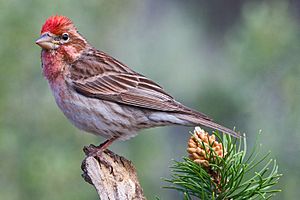
Finches come in many sizes. The smallest true finches are about 9.5 centimeters (3.8 inches) long. They can weigh as little as 8 grams (0.3 ounces). That's super tiny!
The largest finches can be up to 24 centimeters (9.4 inches) long. They can weigh around 83 grams (2.9 ounces). Some, like the pine grosbeak, can be even longer. Others, like the evening grosbeak, can be a bit heavier.
Finches usually have strong, short beaks. In some species, these beaks can be quite large. However, Hawaiian honeycreepers are special. They have many different beak shapes and sizes. This happened as they adapted to eat different foods.
All true finches have 9 main flight feathers on their wings. They also have 12 tail feathers. Their basic feather color is often brownish or greenish. Many also have black markings. White feathers are usually only seen as small marks on their wings.
Many finches have bright yellow and red colors. These colors come from special pigments in their bodies. Blue colors are rare in finches. This is because yellow pigments can turn blue colors into green.
Often, male and female finches look different. The males are usually much brighter and more colorful. The females often do not have the bright yellow and red markings.
Where Do Finches Live?
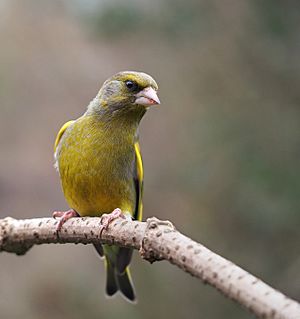
Finches live almost all over the world. You can find them in North and South America, Europe, Asia, and Africa. They also live on some island groups, like the Hawaiian Islands.
However, you won't find finches in Australia, Antarctica, or the islands of the South Pacific and Indian Ocean. But some European finches have been brought to Australia and New Zealand by people.
Finches usually live in areas with lots of trees. This includes forests and woodlands. Some types of finches can also be found in mountains. A few even live in deserts!
What Do Finches Eat?
Finches mainly eat seeds. They are known as granivorous birds. This means their diet is mostly made of grains and seeds.
However, some finches, like the euphoniines, also eat a lot of insects and berries. Hawaiian honeycreepers are very special. They have changed over time to eat many different kinds of food. This includes nectar from flowers.
When finch babies are in the nest, their parents feed them. Their diet includes a mix of small insects and other tiny creatures.
How Do Finches Behave?
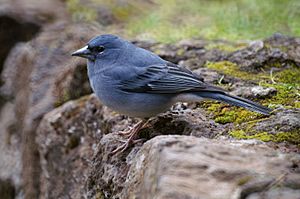
True finches have a bouncy way of flying. Like most small songbirds, they flap their wings, then glide with their wings closed. They repeat this pattern as they fly.
Most finches sing very well. Because of their beautiful songs, several types of finches are kept as cagebirds. The most famous of these is the domesticated canary.
Finch nests are shaped like baskets. They are usually built in trees. Sometimes, they build their nests in bushes, between rocks, or on other similar surfaces.
Images for kids
-
Euphonias, like this thick-billed euphonia, were once thought to be tanagers instead of finches.
-
American goldfinch (Spinus tristis) male (left) and female (right) in Johnston County, North Carolina, USA
-
Hawfinch (Coccothraustes coccothraustes), one of the large-beaked grosbeaks.
-
Hooded siskin (Spinus magellanicus).
-
ʻIʻiwi (Drepanis coccinea), a Hawaiian honeycreeper.
-
Male violaceous euphonia (Euphonia violacea).
-
European goldfinch (Carduelis carduelis).
-
Gran Canaria blue chaffinch (Fringilla polatzeki).
-
Desert finch (Rhodospiza obsoleta).
-
Pine grosbeak (Pinicola enucleator).
-
Evening grosbeak (Hesperiphona vespertina).
-
Yellow-breasted greenfinch (Chloris spinoides).
-
Yellow canary (Crithagra flaviventris).
See also
 In Spanish: Fringílidos para niños
In Spanish: Fringílidos para niños






